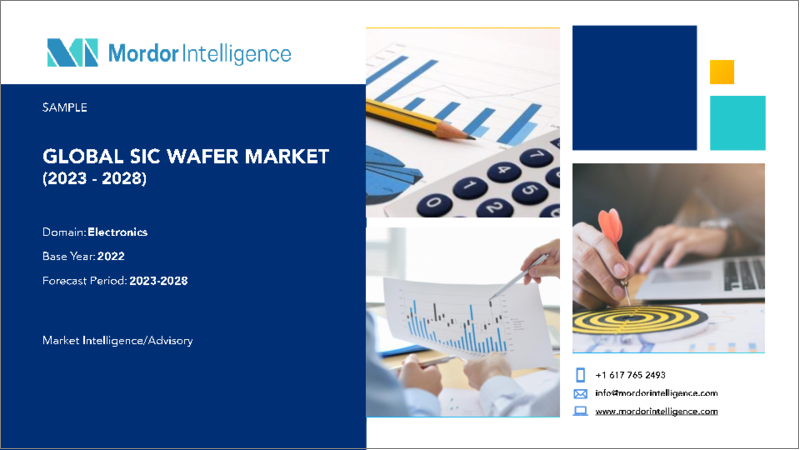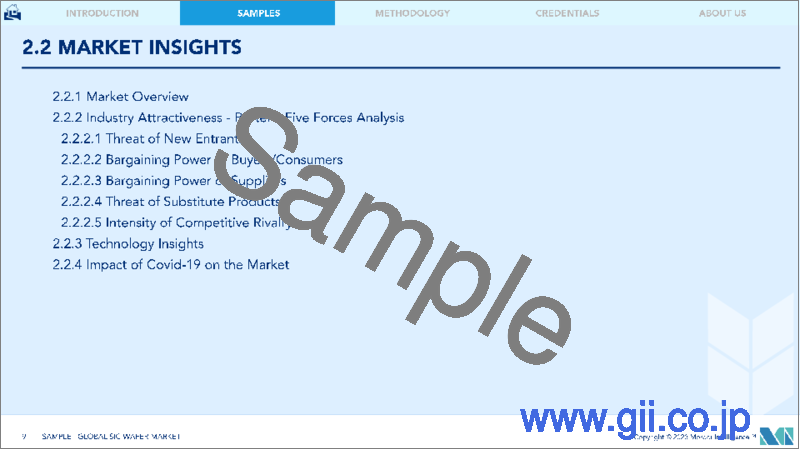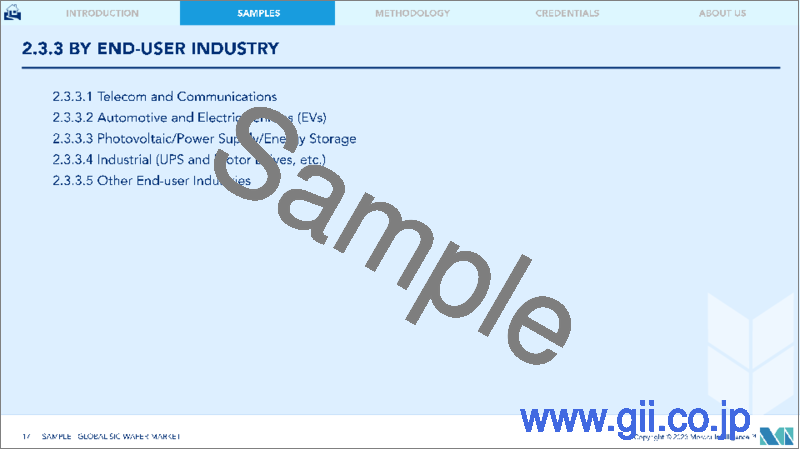|
|
市場調査レポート
商品コード
1198323
SiCウェハ市場- 成長、動向、予測(2023年~2028年)Sic Wafer Market - Growth, Trends, and Forecasts (2023 - 2028) |
||||||
|
● お客様のご希望に応じて、既存データの加工や未掲載情報(例:国別セグメント)の追加などの対応が可能です。 詳細はお問い合わせください。 |
|||||||
| SiCウェハ市場- 成長、動向、予測(2023年~2028年) |
|
出版日: 2023年01月23日
発行: Mordor Intelligence
ページ情報: 英文 127 Pages
納期: 2~3営業日
|
- 全表示
- 概要
- 目次
SiCウェハ市場は、2021年に7億2674万米ドルと評価され、2027年には20億2546万米ドルに達すると予測され、予測期間2022-2027年のCAGRは19.04%を記録しています。
炭化ケイ素(SiC)は、その広いバンドギャップを活かして、ハイパワー用途に使用されています。高性能のパワーICには、SiC基板が使用されることが多いです。SiCは、シリコンや窒化ガリウム(GaN)よりも高温に耐えることができ、電気デバイスの性能を向上させることができます。
主なハイライト
- 自動車業界では、新しいEVは充電時間を短縮し、航続距離と性能を向上させ、顧客の期待に応えています。したがって、自動車会社は、上記の利点を顧客に提供するために、高温で効果的かつ効率的に動作するパワーエレクトロニクスデバイスを必要としています。そのため、SiCを用いたパワーモジュールは、高い熱伝導性、スイッチング損失の低減、電力密度の向上、帯域幅の拡大などの利点から、ワイドバンドギャップSiC技術で開発されています。
- SiCパワー半導体は、各国の内燃機関自動車の新車販売制限が発表されるなど、関心が高まっています。その一環として、調査対象市場で事業を展開する企業は、新たな製造設備を設置するための投資を増やしています。
- 2021年4月、ワイドバンドギャップ化合物半導体の大手企業であるII-VI Incorporatedは、EVとクリーンエネルギー用途の世界最大の市場の1つに対応するため、中国におけるSiCウェハの仕上げ製造拠点を拡大したと発表しました。アジアにおける市場需要の増加に対応するため、同社は中国福州市のアジア地域本部に、導電性SiC基板のバックエンド処理ラインを5万平方フィート以上の新しいクリーンルーム内に設置しました。
- しかし、SiCウェハの市場を考えると、市場関係者は100mmや150mmのウェハを生産してきました。また、200mmウェハの開発に注力している企業もあり、今後数年で本格的に製品化される可能性があります。したがって、SiCウェハの商用サイズは、Siウェハよりも小さいです。このため、SiCベースの半導体は、シリコンベースの半導体に比べて、生産効率や生産速度に限界があります。
- COVID-19の大流行により、半導体製造市場全体が需要面、供給面で影響を受けました。また、世界の半導体工場の操業停止や閉鎖が供給不足に拍車をかけました。この影響は、SiCウェハ市場にも反映されました。しかし、これらの影響の多くは短期的なものにとどまると思われます。世界各国の政府による自動車や半導体分野への支援策により、業界の成長が回復する可能性があります。
SiCウェハの市場動向
自動車・電気自動車のエンドユーザー向け産業が大きく成長
- 従来のシリコンでは電力処理に限界があるため、電気自動車向けのアプリケーションでは、炭化ケイ素などの代替電力技術に道を開くと予想されています。炭化ケイ素(SiC)は、さまざまな用途でシリコン(Si)に代わる最先端技術です。また、電気自動車(EV)の高効率化、航続距離の向上、車両全体の軽量化、低コスト化が進められています。そこで、制御電子機器の高密度化に伴い、EVにSiCを採用するという考え方が生まれました。
- SiCは、シリコンに代わる革新的な技術として、多くのアプリケーションで採用されています。電気自動車にSiCウェハを採用することで、自動車全体の効率、航続距離、重量、コストが向上し、制御電子機器の電力密度を高めることができました。
- さらに、CO2排出量削減に関する政府の要求事項の変化や、さまざまな大手自動車メーカーによる乗用車の電動化が、市場におけるSiCウェハの需要拡大に寄与しています。
- 自動車メーカー各社は、フルハイブリッド電気自動車(HEV)、マイルドハイブリッド電気自動車(MHEV)、プラグインハイブリッド電気自動車(PHEV)、ゼロエミッションバッテリー電気自動車(BEV)、燃料電池電気自動車(FCEV)など、異なる電動化レベルの車両モデルを市場に導入しています。
- 例えば、2021年2月、フォードはドイツ・ケルンの電気自動車生産施設に10億米ドルを投資しました。この投資は、欧州の自動車工場を電気自動車製造に転換するという同社の目標に沿ったものです。
アジア太平洋地域が最大の市場シェアを占める
- アジア太平洋地域は、世界の半導体市場を独占しており、政府の政策にも支えられているため、世界のSiCウェハ市場において重要な地域となっています。さらに、この地域の半導体産業は、台湾、中国、日本、韓国が牽引しており、世界の半導体市場の大きなシェアを占めています。一方、タイ、ベトナム、シンガポール、マレーシアなどの国も、この地域の市場支配に大きく貢献しています。
- 中国は、アジアおよび世界における最大の半導体市場です。半導体産業協会によると、中国は2021年のチップ総売上高が1925億米ドルとなり、前年比27.1%の増加を記録して半導体市場をリードしています。また、多くの大手チップメーカーが新施設を立ち上げてチップ生産を拡大するため、巨額の投資を呼びかけています。
- 2021年6月、中国のSanan Integrated Circuit(SananIC)は、湖南Sanan Semiconductorの工場に国内初の垂直統合型SiCラインを開設しました。湖南省の長沙ハイテク工業団地に位置し、25億米ドルを投資した同社の最新製造ファブは、結晶成長からパワーデバイス、パッケージ、テストまで、ウェハとデバイスの全製造工程を処理します。
- さらに、日本企業は、電気自動車産業の需要に牽引され、SiCパワー半導体の増産に多額の投資を行っています。例えば、日本の富士電機は2022年1月、パワー半導体の生産拠点の1つである富士電機津軽半導体に、SiCパワー半導体の増産に向けた設備投資を決定したと発表しました。量産開始は2024年度を予定しています。
- さらに、東京本社の昭和電工株式会社は、SiCパワー半導体に加工・搭載するSiCエピタキシャルウェハの材料となる直径6インチ(150mm)の炭化ケイ素単結晶ウェハ(SiCウェハ)の量産を2022年3月に開始しました。
SiCウェハ市場の競合他社分析
SiCウェハ市場は競争が激しく、有力なプレーヤーで構成されています。市場で顕著なシェアを持つこれらのプレーヤーは、海外における顧客基盤の拡大に注力しています。また、戦略的な協業により、市場シェアの向上と収益性の強化を図っています。
その他の特典
- エクセル形式の市場予測(ME)シート
- 3ヶ月間のアナリスト・サポート
目次
第1章 イントロダクション
- 調査の前提条件と市場の定義
- 調査対象範囲
第2章 調査手法
第3章 エグゼクティブサマリー
第4章 マーケットインサイト
- 市場概要
- 産業の魅力- ポーターのファイブフォース分析
- 供給企業の交渉力
- 買い手の交渉力
- 新規参入業者の脅威
- 代替品の脅威
- 競争企業間の敵対関係
- 技術インサイト
- COVID-19が市場に与える影響の評価
第5章 市場力学
- 市場促進要因
- 電気自動車(EV)の普及率の上昇と800Vの高電圧EVアーキテクチャへの傾倒がSiCウェハの需要を促進
- 高熱伝導性によるパワーエレクトロニクススイッチとLED照明デバイスでのSiCウェハの需要増加
- 市場の課題
- 微細化、放熱、パッケージングなどの制約がダイと基板供給を圧迫
第6章 市場セグメンテーション
- ウェハサイズ別
- 2インチ、3インチ、4インチ
- 6インチ
- 8インチ、12インチ
- アプリケーション別
- 電力
- 高周波(RF)
- その他のアプリケーション
- エンドユーザー業界別
- テレコム・通信
- 自動車/電気自動車(EV)
- 太陽光発電/電力供給/エネルギー貯蔵
- 産業用(UPS、モータードライブなど)
- その他エンドユーザー産業
- 地域別情報
- 北米
- 欧州
- アジア太平洋地域
- 世界のその他の地域
第7章 競合情勢
- 企業プロファイル
- Wolfspeed Inc.
- II-VI Incorporated
- Xiamen Powerway Advanced Material Co. Ltd
- STMicroelectronics(Norstel AB)
- Showa Denko KK
- Atecom Technology Co. Ltd
- SK Siltron Co. Ltd
- SiCrystal GmbH
- TankeBlue Co. Ltd
- Semiconductor Wafer Inc.
第8章 市場シェア分析
第9章 投資分析
第10章 投資分析市場の将来
The SiC Wafer Market was valued at USD 726.74 million in 2021, and it is expected to reach USD 2,025.46 million by 2027, registering a CAGR of 19.04% during the forecast period 2022-2027. Silicon carbide (SiC) is used for high-power applications owing to its wide bandgap. High-performance power ICs are often based on SiC substrates. SiC can tolerate high temperatures than silicon or gallium nitride (GaN) and improve electrical device performance.
Key Highlights
- In the automotive industry, new EVs have reduced charge time and increased range and performance to meet customer expectations. Hence, automotive companies require power electronic devices capable of effective and efficient operation at elevated temperatures to offer the advantages mentioned above to customers. Thus, power modules are being developed using wide-bandgap SiC technologies, owing to SiC-based technology's advantages, such as high thermal conductivity, reduced switching losses, higher power density, and increased bandwidth capability.
- There has been a growing interest in SiC power semiconductors, with many countries announcing limiting the sales of new internal combustion engine vehicles. As part of these efforts, companies operating in the market studied have been increasing their investments to set up new manufacturing facilities.
- In April 2021, II-VI Incorporated, a leading company operating in wide-bandgap compound semiconductors, announced that it expanded the SiC wafer finishing manufacturing footprint in China to serve one of the largest worldwide markets for EVs and clean energy applications. To meet the increasing market demand in Asia, the company established a backend processing line for conductive SiC substrates in more than 50,000 sq. ft of new cleanroom space at the company's Asia Regional Headquarters in Fuzhou, China.
- However, considering the SiC wafer market, market players have been producing 100 mm and 150 mm wafers. Some companies are focusing on creating 200 mm wafers that may be fully commercialized in the next few years. Hence, commercial sizes of SiC wafers are smaller than Si wafers. This, in turn, limits the efficiency and rate of production of SiC-based semiconductors compared to silicon-based semiconductors.
- The COVID -19 pandemic affected the overall semiconductor manufacturing market from the demand and supply sides. In addition, the global lockdowns and closure of semiconductor plants further fueled the supply shortage. The effects were also reflected in the SiC wafer market. However, many of these effects are likely to be short-term. Precautions by governments across the globe to support automotive and semiconductor sectors could help revive industry growth.
SiC Wafer Market Trends
Automotive and Electric Vehicles End-User Industry Segment to Grow Significantly
- The power-handling limitations of traditional silicon are expected to pave the way for alternative power technologies such as silicon carbide in applications for electric vehicles. Silicon carbide (SiC) is a cutting-edge technology that replaces silicon (Si) in various applications. Moreover, efforts were made to raise the efficiency and range of electric cars (EVs) while reducing the weight and cost of the complete vehicle. Thus, with the increasing power density of control electronics, the notion of employing SiC for EVs was formed.
- SiC is an innovative technology used to replace silicon in many applications. The adoption of SiC wafers in electric vehicles has increased the efficiency, range, weight, and cost of the entire vehicle, thereby increasing the power density of control electronics.
- Moreover, changing government requirements regarding the reduction of CO2 emissions coupled with the electrification of passenger vehicles by various major automakers are contributing to the growth of demand for SiC wafers in the market.
- Vehicle models with different electrification levels have been introduced to the market by automakers, including full hybrid electric vehicles (HEVs), mild-hybrid electric vehicles (MHEVs), plug-in hybrid electric vehicles (PHEVs), zero-emission battery electric vehicles (BEVs), and fuel-cell electric vehicle (FCEVs), among others.
- For instance, in February 2021, Ford invested USD 1 billion in an electric vehicle production facility in Cologne, Germany. The investment aligns with the company's aims to convert its European arm of automotive plants to manufacture electric vehicles.
Asia-Pacific Hold the Largest Market Share
- The Asia-Pacific is a prominent region in the global SiC wafer market, as the region dominates the global semiconductor market, which is also supported by government policies. Furthermore, the region's semiconductor industry is driven by Taiwan, China, Japan, and South Korea, which account for a significant share of the global semiconductor market. In contrast, others, like Thailand, Vietnam, Singapore, and Malaysia, contribute significantly to the region's dominance in the market.
- China is the largest semiconductor market in Asia and globally. As per the semiconductor industry association, China led the semiconductor market with a total chip sales of USD 192.5 billion in 2021, marking an increase of 27.1% year on year. The country is also attracting huge investments from many major chipmakers to expand chip production by launching new facilities.
- In June 2021, China-based Sanan Integrated Circuit (Sanan IC) opened the nation's first vertically integrated SiC line at its Hunan Sanan Semiconductor plant. Located in the Changsha high-tech industrial park in the Hunan province, the company's latest manufacturing fab, with a USD 2.5 billion investment, handles all wafer and device fabrication steps from crystal growth to power devices, packaging, and testing.
- Furthermore, Japanese companies are making heavy investments to increase the production of SiC power semiconductors driven by the demand from the EV industry. For instance, in January 2022, Japan-based Fuji Electric Co. Ltd announced the decision to invest capital in Fuji Electric Tsugaru Semiconductor Co. Ltd, one of its power semiconductor production bases, for an increase in the production of SiC power semiconductors. Mass production is planned to begin in fiscal 2024.
- Furthermore, in March 2022, Tokyo-headquartered Showa Denko KK launched the mass production of silicon carbide single crystal wafers (SiC wafers) with a diameter of 6 inches (150 mm), which are used as materials for SiC epitaxial wafers to be processed and installed into SiC power semiconductors.
SiC Wafer Market Competitor Analysis
The SiC wafer market is highly competitive and consists of some influential players. These players, with a noticeable share in the market, are concentrating on expanding their customer base across foreign countries. They leverage strategic collaborative actions to improve their market percentage and enhance their profitability.
- March 2022 - Showa Denko KK started the mass manufacturing of silicon carbide single crystal wafers (SiC wafers) with a diameter of 6 inches (150 mm), which would be processed and integrated into SiC-based power semiconductors.
- February 2022 - II-VI Incorporated announced that it had qualified its 1200 V silicon carbide MOSFET platform, on its high-quality SiC substrates, to stringent automotive standard requirements. Additionally, the company expanded its relationship with GE by signing a three-year technology access agreement (TAA) with GE Research to access the Lab's global-class SiC module technology and the team of experts to accelerate customer design-in engagement activities.
Additional Benefits:
- The market estimate (ME) sheet in Excel format
- 3 months of analyst support
TABLE OF CONTENTS
1 INTRODUCTION
- 1.1 Study Assumptions and Market Definition
- 1.2 Scope of the Study
2 RESEARCH METHODOLOGY
3 EXECUTIVE SUMMARY
4 MARKET INSIGHT
- 4.1 Market Overview
- 4.2 Industry Attractiveness - Porter's Five Forces Analysis
- 4.2.1 Bargaining Power of Suppliers
- 4.2.2 Bargaining Power of Buyers
- 4.2.3 Threat of New Entrants
- 4.2.4 Threat of Substitute Products
- 4.2.5 Intensity of Competitive Rivalry
- 4.3 Technology Insights
- 4.4 Assessment of the Impact of COVID-19 on the Market
5 MARKET DYNAMICS
- 5.1 Market Drivers
- 5.1.1 Rising Penetration Rate of Electric Vehicles (EVs) and the Inclination Toward High-voltage 800V EV Architectures Propelling the Demand for SiC Wafers
- 5.1.2 Increasing Demand for SiC Wafers in Power Electronics Switches and LED Lighting Devices due to its High Thermal Conductivity
- 5.2 Market Challenges
- 5.2.1 Limiting Constraints such as Scalability, Heat Dissipation, and Packaging-related Pressure on the Die and Substrate Supply
6 MARKET SEGMENTATION
- 6.1 By Wafer Size
- 6.1.1 2-, 3-, and 4-inch
- 6.1.2 6-inch
- 6.1.3 8- and 12-inch
- 6.2 By Application
- 6.2.1 Power
- 6.2.2 Radio Frequency (RF)
- 6.2.3 Other Applications
- 6.3 By End-user Industry
- 6.3.1 Telecom & Communications
- 6.3.2 Automotive & Electric Vehicles (EVs)
- 6.3.3 Photovoltaic/Power Supply/Energy Storage
- 6.3.4 Industrial (UPS and Motor Drives, etc.)
- 6.3.5 Other End-user Industries
- 6.4 By Geography
- 6.4.1 North America
- 6.4.2 Europe
- 6.4.3 Asia-Pacific
- 6.4.4 Rest of the World
7 COMPETITIVE LANDSCAPE
- 7.1 Company Profiles
- 7.1.1 Wolfspeed Inc.
- 7.1.2 II-VI Incorporated
- 7.1.3 Xiamen Powerway Advanced Material Co. Ltd
- 7.1.4 STMicroelectronics (Norstel AB)
- 7.1.5 Showa Denko KK
- 7.1.6 Atecom Technology Co. Ltd
- 7.1.7 SK Siltron Co. Ltd
- 7.1.8 SiCrystal GmbH
- 7.1.9 TankeBlue Co. Ltd
- 7.1.10 Semiconductor Wafer Inc.




